Steld targett with a gret bosse fringed with silke
Wherein a poor misguided woodworker tries to make armour (or is it armor?)...
Steld targett with a gret bosse fringed with silke
Wherein a poor misguided woodworker tries to make armour (or is it armor?)...
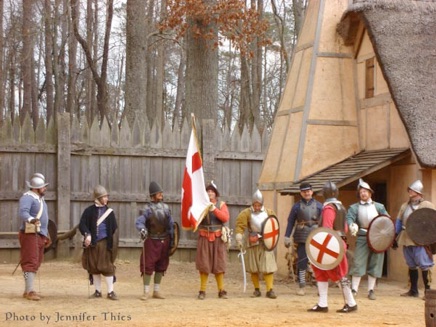
By the 16th century, the use of shields in the English military was on the wane. The introduction of practical firearms had changed battlefield tactics, and defensive formations were more likely to consist of a pike block than a shield wall.
Of the shields that were still used, we now divide them into two sorts: the Target and the Buckler. It may be a somewhat artificial distinction, but generally, a target has two straps and is worn on the arm, while a buckler has a single handle at the center (and was thus often smaller, though some could be used either way). Some were very plain, while others had ornate decoration, hanging lanterns, hooks and slots to catch sword blades, and spiked bosses. Even with their waning military values, they seem to have remained popular for ceremonial purposes, and quite a number are listed in Henry VIII's inventory. They are variously described:
* Item Targettes of Stele fringed with Redde silke and golde and lyned with vellet ij
* Item CC blacke stele Targettes made of olde harnesse
* Targettes steilde with gonnes
* Targettes playne without gonnes
* Tergett with xxth litle gonnes
* Tergett with iij gonnes
* A longe target with oone gonne
* A tergett of the shell of a Tortys
* Tergettes olde broken
* Targettes playne paynted gilte
* Tergettes paynted gilte lyned with blacke velvet
* Targettes oone blake and an other white
* Targettes paynted and gilte fringed with silke
* Targettes paynted and gilted of sondry sortes not fringed
* Targettes with gonnes
* Targettes playne without gones fringed with silke
* Targetes playne without frindges
* Steld targett with a gret bosse fringed with silke & gold
* Steeld targettes lynded with velvet
* Steeld targettes with gonnes
* Tergett of Buffe ledder
* Tergett of ledder gilte
* Targettes rounde covered with tawny ledder.
* Rounde targettes covered with blake ledder
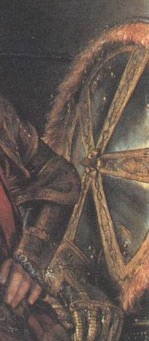
One curious attempt to make the shield relevant again that we see in this inventory was a combination shield and hand gun. Several were found on Henry's warship the Mary Rose, and other examples are found in the Tower of London. They consist of steel plates, usually attached to a frame of wooden lathe, with an opening for a small gun. They were apparently not a great success, and I have heard of no examples of their actual use in war (though they were found on a warship). For more detailed information on a Tudor gun shield from their collection, see this article from the Victoria and Albert Museum.
While little used by the 17th century, they saw something of a revival in Virginia. English colonists learned that rather than pike blocks (best against cavalry and massed infantry), defense against the natives could be achieved by lightly armored men with stout shields and swords (and pistols if available). Known as targeteers, these soldiers could defend musketeers and calivermen while they reloaded, and then engage the enemy at close range with their swords and pistols.
Part The Second, Making a Target
My inspiration for making a target wasn't from a land dispute with the native Americans, but rather the upcoming 400th anniversary of the English landing at Jamestown. Among the planned activities are demonstrations of period military drills, and since I don't shoot, Targeteer seemed like a good impression to work on.
From documentation, we know that the English settlers used both wooden and steel targets. While the wooden targets were thought to be proof to pistols, there is at least one account of an Indian arrow going through one by several inches, while shattering against a steel target. Unfortunately, I have found no information regarding surviving wooden targets of this era, and it's very possible that none have survived, being a disposable sort of thing. Of those that survive from the 16th and 17th centuries, they are either steel, or a combination of steel over wooden lathe. Not being an armorer, the latter seemed to be an easier approach. The model for my target is the gun shield discussed in the V&A article mentioned above. Their examination led them to suspect that it started life as a "playne targette" and that the gun was added later.
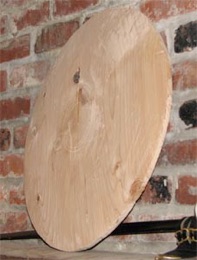
To achieve the convex face and concave back I wanted thick stock, so I started with a blank of common "two-by" stud lumber. Two 2 x 12's can be glued up for a shield just about 22 inches in diameter. I scribed the circle out with a large compass and then cut it with a (gasp!) reciprocating saw. With the blank cut out, it's just a matter of paring off wood from the face and back. Hand chisels and gouges work well, a hand power planer does the job even quicker.
The next task is to make a template for the face plates. While the V&A gun shield has 13 plates, I found the odd number awkward to work with, and another examples in Stone's Glossary shows one with 12 plates. That makes each plate 30-degrees of arc. I made a template of stiff paper which I used to trace out each plate on a sheet of 22-gauge plain steel (do not use zinc'ed steel). While 22 gauge is light for armour, it can still be easily cold worked by hand. Power shears would make short work of cutting the plates, I managed using a hefty pair of hand snips.
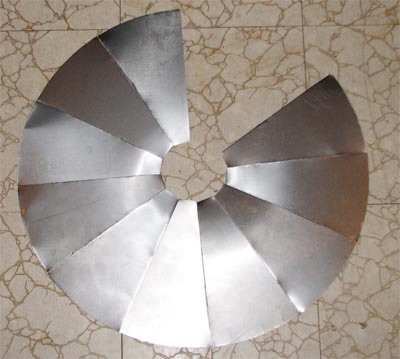
The plates of the original have a drop-shaped fluting, but for my limited skills I decided to go with a simple straight flute. To do this, I made a simple jig with nails to hold each plate, and a channel cut down the centerline. Then I simply used a steel set (later a small froe), applied with a small sledge to score the flute.
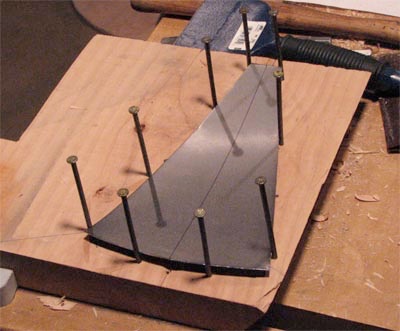
The results, while not stunning, were acceptable.
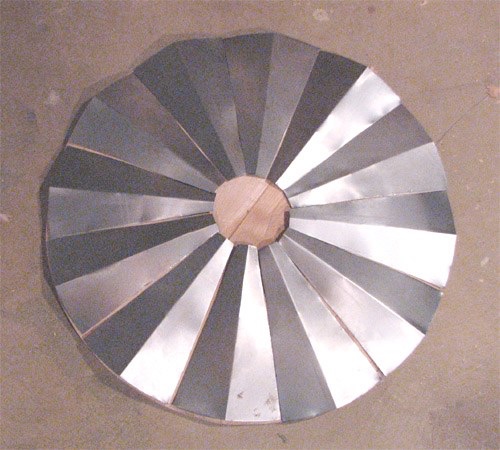
Each plate is held in place by five nails, three along the outer edge and two just outside the space for the boss. I found it easiest to pre-drill the holes using a drill press. The next step was to apply the plates to the face of the shield. I used soft clench nails, with the heads cleaned of their zinc coating. Each plate was gently bent into the approximate curve of the shield face. I then pre-drilled a hole through the wooden core, drove the nail in place, and then clenched it from the back.
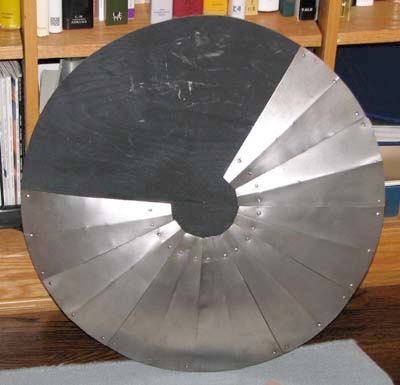
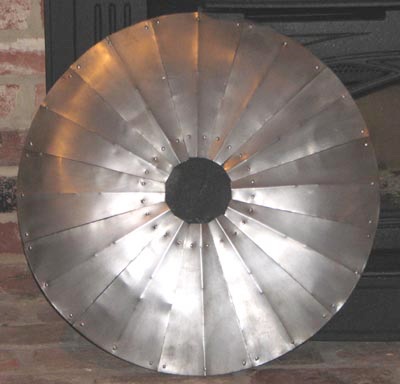
The boss is simple a circle of steel, with flutes punched to match the flutes of the outside plates. I recommend completing the outside plates first, as the flutes may not be quite evenly spaced. Once formed, the boss is predrilled and then nailed in place.
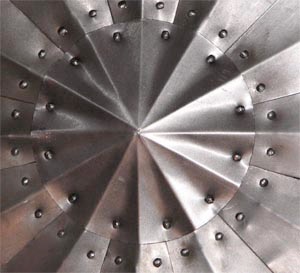
Here is the first shield with all plates in place.
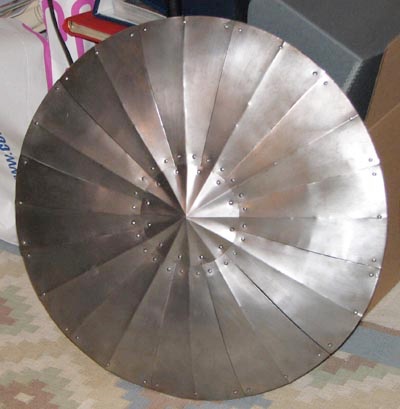
Elizabethan soldiers were all about show, so I didn't want just a plain target. A lining of hemp canvas with some quilted padding would add some comfort, and a red fringe would add flash.
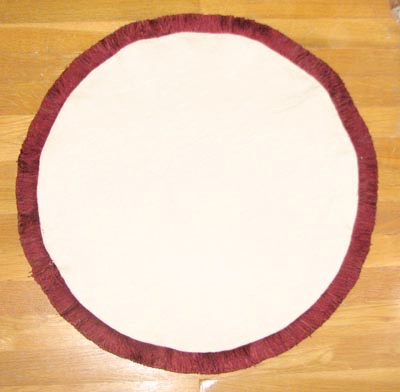
I started by cutting a circle of canvas, then sitching over the edges while attaching a strip of upholstery fringe.
I also sewed on a pocket for additional padding under the arm. Padding was cut from an old mattress pad (cheap and on-hand), then padding and lining were tacked to the inside of the shield using brass tacks. Additionally I tacked on a leather strip about the circumference of the shield to add some finish and cover a few protruding edges.
For the strapping, I copied a diagram from the Mary Rose Trust on how they believe a gun shield was strapped.
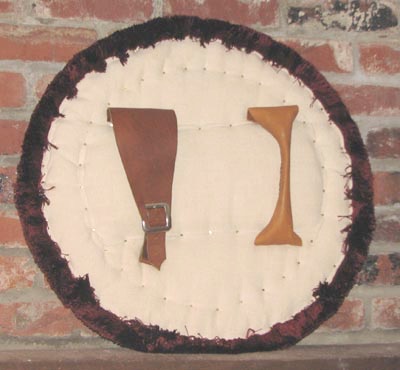
Three targets waiting for the next muster.
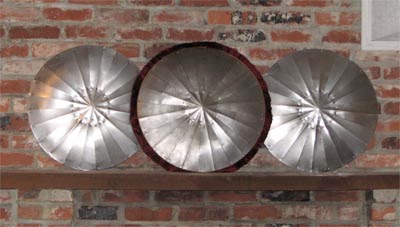
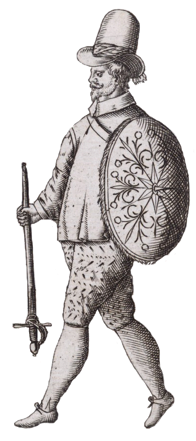


Copyright 2009, Thomas Rettie.